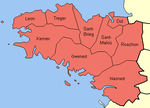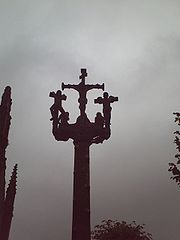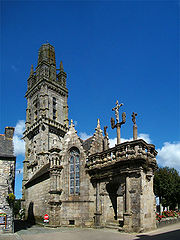
Lampaul-Guimiliau
Encyclopedia
Lampaul-Guimiliau is a commune
in the Finistère
department of Brittany in northwestern France
.
It is noted for its parish
close
.
 The place name element lan or lam (llan in Welsh) originally signified an enclosure, particularly a sacred enclosure, and later came to mean a church. The name Lampaul therefore means church or enclosure dedicated to St Paulinus
The place name element lan or lam (llan in Welsh) originally signified an enclosure, particularly a sacred enclosure, and later came to mean a church. The name Lampaul therefore means church or enclosure dedicated to St Paulinus
. St Pol, Paol, Paul or Paulinus was one of the seven founder saints of Brittany, a 6th century Welsh
missionary
closely associated with the Léon diocese
of Brittany, in which Lampaul-Guimiliau is situated. Parish closes are a distinctive feature of this diocese, although they are not entirely confined to it.
In the Middle Ages, the village was part of the parish of Guimiliau
. This means township of St Miliau, a Breton saint of the 6th or 9th century. Later, rising prosperity and economic growth brought separate status, with a separate parish church. Hence the name in full means St Pol's Church in the Settlement of St Miliau.
 Parish close
Parish close
s are a distinctive feature of the Breton culture of the Léon region. The close is so-called because it is a church yard entirely enclosed by a wall, with a ceremonial entrance arch. The closes of the Léon diocese date from the 16th and early 17th centuries, when the area was at the peak of its prosperity, founded on the hemp industry and on Channel and Atlantic trade.
 The parish close of Lampaul-Guimiliau commands the road junction at the centre of the village. It is one of the best examples of its kind. It contains not only the church and graveyard of the parish, but also a large and elaborate calvary
The parish close of Lampaul-Guimiliau commands the road junction at the centre of the village. It is one of the best examples of its kind. It contains not only the church and graveyard of the parish, but also a large and elaborate calvary
or crucifix
and a noted charnel house
, both common features of Breton closes, and a vast belfry
. The church and charnel house display a large body of polychrome
sculpture, mainly of 16th or 17th century date and rich in complex Christian iconography, reflecting the preoccupations of the Counter-Reformation
or Catholic Reformation.
 The belfry or bell tower
The belfry or bell tower
, constructed from 1573, was originally one of the highest in Finistère. However it was truncated by fire following a lightning strike in 1809.
or ossuary
dates from 1667 and was designed by the architect Guillaume Kerlezroux. it is dominated by a retable
portraying the Risen Christ
. Formerly it also housed a notable tableau of the Entombment of Christ
, which has now been moved into the church itself.
sculpture and decoration. Dominating the nave
is a 16th century rood screen
, showing the crucified Christ, attended by the Virgin Mary and St John the Apostle
. Below this, scenes of the Passion are represented in rich detail.
A number of complex retable
s focus on the Passion and on the lives and deeds of saints, including John the Baptist
, St Margaret the Virgin
, and St Lawrence. Each is divided into numerous panels, with episodes modelled in relief, and each is flanked by free-standing statuary. There are also a number of important separate free-standing pieces, including an oak Descent from the Cross
, the Entombment, and St Pol.
The baptistery
is one of the most striking among the parish closes. It is an octagonal Baroque
concoction, dating from about 1650. Unlike most of its kind, it is elaborately polychrome, with highly-elaborate pillars and finely-modelled representation of the baptism
of Christ.
The church also displays its banners. These are an important artifact of Breton culture. They form a rallying point for parishioners attending the local pilgrimage festivals, known as pardons
.
Lampaulais.
A guide to the church, in French, with an introduction to the cultural and historical background to parish closes.
Communes of France
The commune is the lowest level of administrative division in the French Republic. French communes are roughly equivalent to incorporated municipalities or villages in the United States or Gemeinden in Germany...
in the Finistère
Finistère
Finistère is a département of France, in the extreme west of Brittany.-History:The name Finistère derives from the Latin Finis Terræ, meaning end of the earth, and may be compared with Land's End on the opposite side of the English Channel...
department of Brittany in northwestern France
France
The French Republic , The French Republic , The French Republic , (commonly known as France , is a unitary semi-presidential republic in Western Europe with several overseas territories and islands located on other continents and in the Indian, Pacific, and Atlantic oceans. Metropolitan France...
.
It is noted for its parish
Parish
A parish is a territorial unit historically under the pastoral care and clerical jurisdiction of one parish priest, who might be assisted in his pastoral duties by a curate or curates - also priests but not the parish priest - from a more or less central parish church with its associated organization...
close
Parish close
Parish close is a translation of the French term enclos paroissial. It refers to a number of locations Brittany, mainly though not exclusively in the historic diocese of Léon, corresponding roughly to the northern half of the département of Finistère, in Brittany...
.
Etymology

Paul Aurelian
Paul Aurelian is a 6th century Welsh saint, who became one of the seven founder saints of Brittany....
. St Pol, Paol, Paul or Paulinus was one of the seven founder saints of Brittany, a 6th century Welsh
Welsh people
The Welsh people are an ethnic group and nation associated with Wales and the Welsh language.John Davies argues that the origin of the "Welsh nation" can be traced to the late 4th and early 5th centuries, following the Roman departure from Britain, although Brythonic Celtic languages seem to have...
missionary
Missionary
A missionary is a member of a religious group sent into an area to do evangelism or ministries of service, such as education, literacy, social justice, health care and economic development. The word "mission" originates from 1598 when the Jesuits sent members abroad, derived from the Latin...
closely associated with the Léon diocese
Diocese
A diocese is the district or see under the supervision of a bishop. It is divided into parishes.An archdiocese is more significant than a diocese. An archdiocese is presided over by an archbishop whose see may have or had importance due to size or historical significance...
of Brittany, in which Lampaul-Guimiliau is situated. Parish closes are a distinctive feature of this diocese, although they are not entirely confined to it.
In the Middle Ages, the village was part of the parish of Guimiliau
Guimiliau
Guimiliau is a commune in the Finistère department of Brittany in north-western France.It is noted for its parish close. It should not be confused with the neighbouring commune and village of Lampaul-Guimiliau.-Population:...
. This means township of St Miliau, a Breton saint of the 6th or 9th century. Later, rising prosperity and economic growth brought separate status, with a separate parish church. Hence the name in full means St Pol's Church in the Settlement of St Miliau.
Parish close

Parish close
Parish close is a translation of the French term enclos paroissial. It refers to a number of locations Brittany, mainly though not exclusively in the historic diocese of Léon, corresponding roughly to the northern half of the département of Finistère, in Brittany...
s are a distinctive feature of the Breton culture of the Léon region. The close is so-called because it is a church yard entirely enclosed by a wall, with a ceremonial entrance arch. The closes of the Léon diocese date from the 16th and early 17th centuries, when the area was at the peak of its prosperity, founded on the hemp industry and on Channel and Atlantic trade.

Calvary
Calvary or Golgotha was the site, outside of ancient Jerusalem’s early first century walls, at which the crucifixion of Jesus is said to have occurred. Calvary and Golgotha are the English names for the site used in Western Christianity...
or crucifix
Crucifix
A crucifix is an independent image of Jesus on the cross with a representation of Jesus' body, referred to in English as the corpus , as distinct from a cross with no body....
and a noted charnel house
Charnel house
A charnel house is a vault or building where human skeletal remains are stored. They are often built near churches for depositing bones that are unearthed while digging graves...
, both common features of Breton closes, and a vast belfry
Bell tower
A bell tower is a tower which contains one or more bells, or which is designed to hold bells, even if it has none. In the European tradition, such a tower most commonly serves as part of a church and contains church bells. When attached to a city hall or other civic building, especially in...
. The church and charnel house display a large body of polychrome
Polychrome
Polychrome is one of the terms used to describe the use of multiple colors in one entity. It has also been defined as "The practice of decorating architectural elements, sculpture, etc., in a variety of colors." Polychromatic light is composed of a number of different wavelengths...
sculpture, mainly of 16th or 17th century date and rich in complex Christian iconography, reflecting the preoccupations of the Counter-Reformation
Counter-Reformation
The Counter-Reformation was the period of Catholic revival beginning with the Council of Trent and ending at the close of the Thirty Years' War, 1648 as a response to the Protestant Reformation.The Counter-Reformation was a comprehensive effort, composed of four major elements:#Ecclesiastical or...
or Catholic Reformation.
Belfry

Bell tower
A bell tower is a tower which contains one or more bells, or which is designed to hold bells, even if it has none. In the European tradition, such a tower most commonly serves as part of a church and contains church bells. When attached to a city hall or other civic building, especially in...
, constructed from 1573, was originally one of the highest in Finistère. However it was truncated by fire following a lightning strike in 1809.
Charnel house
The charnel houseCharnel house
A charnel house is a vault or building where human skeletal remains are stored. They are often built near churches for depositing bones that are unearthed while digging graves...
or ossuary
Ossuary
An ossuary is a chest, building, well, or site made to serve as the final resting place of human skeletal remains. They are frequently used where burial space is scarce. A body is first buried in a temporary grave, then after some years the skeletal remains are removed and placed in an ossuary...
dates from 1667 and was designed by the architect Guillaume Kerlezroux. it is dominated by a retable
Retable
A retable is a framed altarpiece, raised slightly above the back of the altar or communion table, on which are placed the cross, ceremonial candlesticks and other ornaments....
portraying the Risen Christ
Christ
Christ is the English term for the Greek meaning "the anointed one". It is a translation of the Hebrew , usually transliterated into English as Messiah or Mashiach...
. Formerly it also housed a notable tableau of the Entombment of Christ
Entombment of Christ
The Entombment redirects here. For other uses, The Entombment The Entombment of Christ, that is to say the burial of Jesus Christ, occurred after his death by crucifixion, when, according to the gospel accounts, he was placed in a new tomb belonging to Joseph of Arimathea.-Biblical account:All four...
, which has now been moved into the church itself.
Polychrome interior
The interior of the church is replete with polychromePolychrome
Polychrome is one of the terms used to describe the use of multiple colors in one entity. It has also been defined as "The practice of decorating architectural elements, sculpture, etc., in a variety of colors." Polychromatic light is composed of a number of different wavelengths...
sculpture and decoration. Dominating the nave
Nave
In Romanesque and Gothic Christian abbey, cathedral basilica and church architecture, the nave is the central approach to the high altar, the main body of the church. "Nave" was probably suggested by the keel shape of its vaulting...
is a 16th century rood screen
Rood screen
The rood screen is a common feature in late medieval church architecture. It is typically an ornate partition between the chancel and nave, of more or less open tracery constructed of wood, stone, or wrought iron...
, showing the crucified Christ, attended by the Virgin Mary and St John the Apostle
John the Apostle
John the Apostle, John the Apostle, John the Apostle, (Aramaic Yoħanna, (c. 6 - c. 100) was one of the Twelve Apostles of Jesus. He was the son of Zebedee and Salome, and brother of James, another of the Twelve Apostles...
. Below this, scenes of the Passion are represented in rich detail.
A number of complex retable
Retable
A retable is a framed altarpiece, raised slightly above the back of the altar or communion table, on which are placed the cross, ceremonial candlesticks and other ornaments....
s focus on the Passion and on the lives and deeds of saints, including John the Baptist
John the Baptist
John the Baptist was an itinerant preacher and a major religious figure mentioned in the Canonical gospels. He is described in the Gospel of Luke as a relative of Jesus, who led a movement of baptism at the Jordan River...
, St Margaret the Virgin
Margaret the Virgin
Margaret the Virgin, also known as Margaret of Antioch , virgin and martyr, is celebrated as a saint by the Roman Catholic and Anglican Churches on July 20; and on July 17 in the Orthodox Church. Her historical existence has been questioned; she was declared apocryphal by Pope Gelasius I in 494,...
, and St Lawrence. Each is divided into numerous panels, with episodes modelled in relief, and each is flanked by free-standing statuary. There are also a number of important separate free-standing pieces, including an oak Descent from the Cross
Descent from the Cross
The Descent from the Cross , or Deposition of Christ, is the scene, as depicted in art, from the Gospels' accounts of Joseph of Arimathea and Nicodemus taking Christ down from the cross after his crucifixion . In Byzantine art the topic became popular in the 9th century, and in the West from the...
, the Entombment, and St Pol.
The baptistery
Baptistery
In Christian architecture the baptistry or baptistery is the separate centrally-planned structure surrounding the baptismal font. The baptistry may be incorporated within the body of a church or cathedral and be provided with an altar as a chapel...
is one of the most striking among the parish closes. It is an octagonal Baroque
Baroque
The Baroque is a period and the style that used exaggerated motion and clear, easily interpreted detail to produce drama, tension, exuberance, and grandeur in sculpture, painting, literature, dance, and music...
concoction, dating from about 1650. Unlike most of its kind, it is elaborately polychrome, with highly-elaborate pillars and finely-modelled representation of the baptism
Baptism
In Christianity, baptism is for the majority the rite of admission , almost invariably with the use of water, into the Christian Church generally and also membership of a particular church tradition...
of Christ.
The church also displays its banners. These are an important artifact of Breton culture. They form a rallying point for parishioners attending the local pilgrimage festivals, known as pardons
Pardon (ceremony)
A Pardon is a typically Breton form of pilgrimage and one of the most traditional demonstrations of popular Catholicism in Brittany. Of very ancient origin, probably dating back to the conversion of the country by the Celtic monks, it is comparable to the parades associated with Saint Patrick's Day...
.
Population
Inhabitants of Lampaul-Guimiliau are called in FrenchFrench language
French is a Romance language spoken as a first language in France, the Romandy region in Switzerland, Wallonia and Brussels in Belgium, Monaco, the regions of Quebec and Acadia in Canada, and by various communities elsewhere. Second-language speakers of French are distributed throughout many parts...
Lampaulais.
Further reading
Yannick Pelletier, Lampaul-Guimiliau, Editions Jean-Paul Gisserot, 2005. ISBN 9 782877 474986A guide to the church, in French, with an introduction to the cultural and historical background to parish closes.

